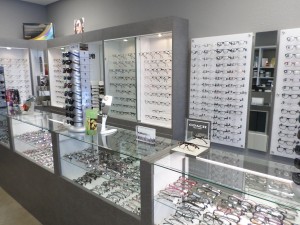
When purchasing glasses for a child, it’s important to consider both the product and the process. Photo: Site for Sore Eyes – Napa (2016)
With Harry Mankabadi, Manager of Site for Sore Eyes – Dublin, and Sheryl Duerksen, Manager of Site for Sore Eyes – Napa
Shopping for eyewear is difficult enough for adults, but when it’s for kids, there are additional factors that further complicate matters. For example, besides selecting the product itself, parents must also be intentional about the process of choosing glasses for their children. To more closely focus on this topic, we’ve asked two Diamond Certified opticians to discuss some important considerations.
1. Educate your child. First and foremost, before you set foot in an eyewear store, take some time to talk to your child and explain why they need glasses. Depending on their stage of development, they may have difficulty comprehending the situation, so do your best to communicate at an age-appropriate level. Once at the store, your optician can provide further assistance in educating your child. “It’s important for children to understand why they’re getting glasses,” affirms Harry Mankabadi, manager of Site for Sore Eyes – Dublin. “In addition to verbally explaining things to them, an optician can show them some sample glasses to demonstrate how it sharpens their vision.”
2. Involve them in the process. Regardless of how much explaining you do, you may find that your child fails to appreciate the gravity of the situation. Don’t get frustrated—as Sheryl Duerksen, manager of Site for Sore Eyes – Napa explains, this is totally normal. “You can’t just tell a child, ‘You need to do this because of x, y and z’ and expect them to understand,” she says. “The fact is that most young children haven’t yet developed the capacity for that kind of rationalizing.”
For this reason, Ms. Duerksen says your best strategy is to involve your child in the process of choosing their glasses, which will help instill a sense of ownership. Additionally, she suggests choosing a frame that your child finds appealing, whether it’s a favorite color or a design featuring a popular cartoon character. “You need to make sure it’s something the child likes, because if they don’t, they won’t want to wear it, no matter how much you emphasize its importance.”
3. Look at frame durability and fit. Due to children’s physically active (not to mention clumsy) nature, durability is a chief concern when choosing eyewear frames. In this regard, Mr. Mankabadi lists a couple of different choices. “One frame material I specifically recommend for children is ‘memory titanium,’ because it’s very light and extremely flexible,” he says. “There are also quality plastic frames available for parents who prefer a non-metallic option.” Additionally, Ms. Duerksen says children’s eyewear frames should be equipped with spring hinges, which provide greater flexibility against breaking, as well as a snugger fit to keep them from falling off.
Besides considering frame material, be sure to observe how the frames fit on your child’s face. “In particular, it’s important to assess the bridge of the frames and how it fits on the child’s nose,” says Mr. Mankabadi. “If the frames are constantly slipping off his or her nose, that’s going to deter your child from wanting to wear them, so it’s crucial to confirm a correct fit.”
4. Be aware of lens safety requirements. “California law requires kids’ glasses to have shatter- and impact-resistant lenses, which provide protection in the event of breakage,” explains Ms. Duerksen. “The most common lens material is polycarbonate, which is the same material that’s used in safety glasses.” Mr. Mankabadi says another option for lens material is Trivex, which, while more expensive, exceeds polycarbonate in terms of durability and clarity. In either case, make sure your optician is familiar with the law and provides a safe lens product for your child’s glasses.
5. Ask about lens coating options. In addition to requisite safety features, there are several optional features worth considering when buying glasses for your child, one of which is anti-reflective coating. “By eliminating glare, anti-reflective coating benefits both the child wearing the glasses and the people around him,” explains Mr. Mankabadi. “In some cases, parents will actually remove their child’s glasses because the glare is irritating them. To provide greater overall comfort, I recommend investing in an anti-reflective coating.”
Another option to consider is photochromic lenses. Also known as “transitional” lenses, photochromic lenses regulate UV exposure by adjusting their tint in conjunction with the intensity of the light that hits them. Imagine a hybrid of sunglasses and regular glasses and you’ll get the picture. Additionally, a more recent eyewear innovation is lens coatings that filter out “blue light,” which is a form of UV light emitted by tablets, smartphones and other LED screen devices. Between the two aforementioned features, your child’s eyes will be protected whether they’re playing outdoors or doing an activity on a tablet.
One final consideration
Once you’ve purchased glasses for your child, you may think that’s the end of it. However, remember that you’ll need to keep routine follow-up appointments, which, according to Ms. Duerksen, are more frequent for kids than adults. “For adults, I usually recommend a reassessment every two years to make any needed prescription adjustments, but for kids, I recommend it annually,” she says. “Since children are constantly growing, their eyes have a tendency to change a lot faster, which means they may need their prescriptions updated more often.”
To learn more about caring for your child’s eye health, read our related article, “Caring for Your Child’s Eyes.” To find a Diamond Certified optician in your area, visit www.diamondcertified.info.
